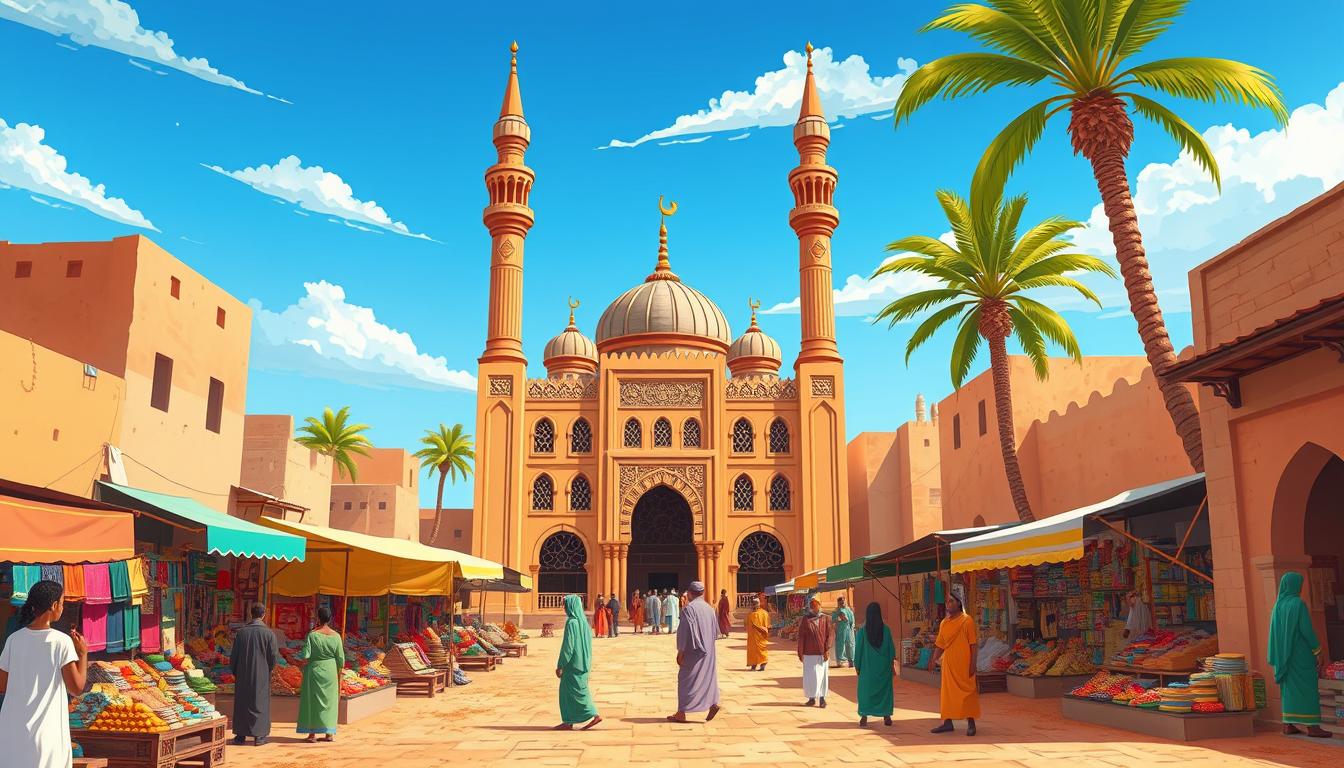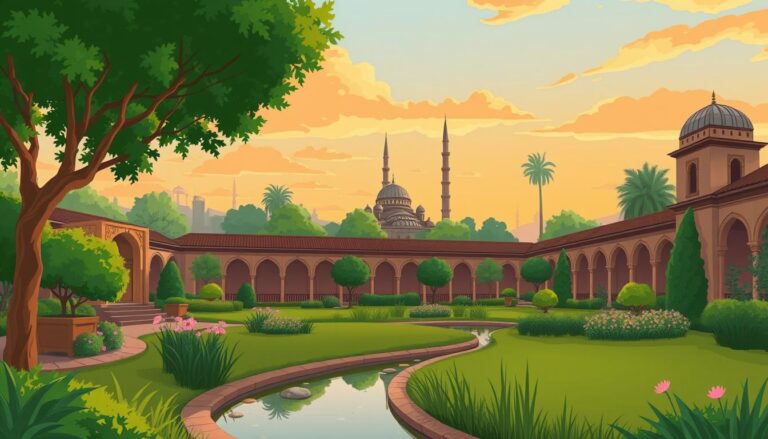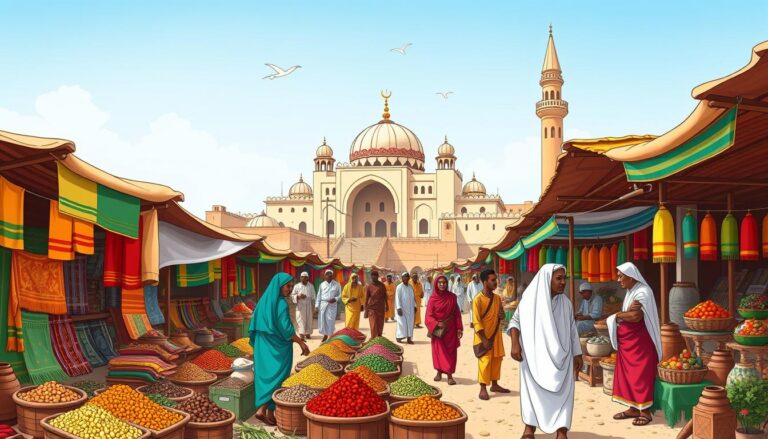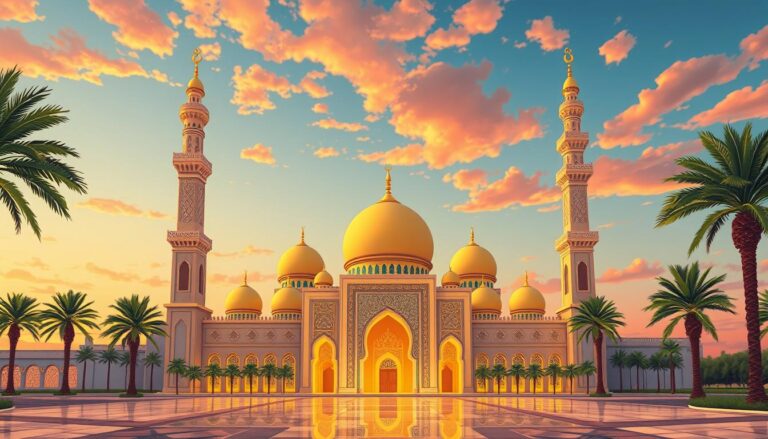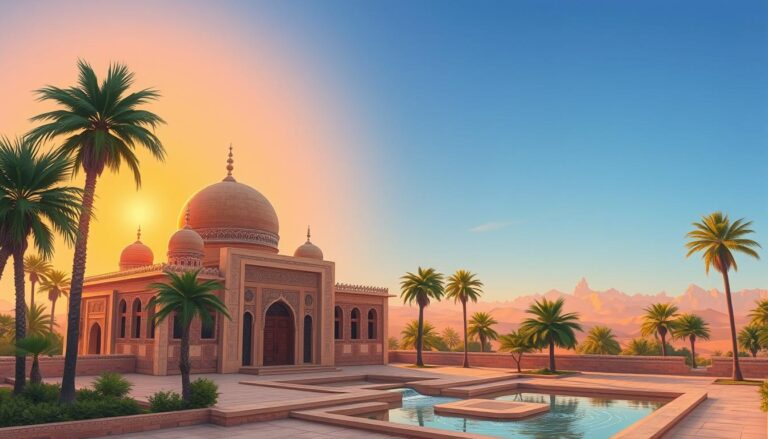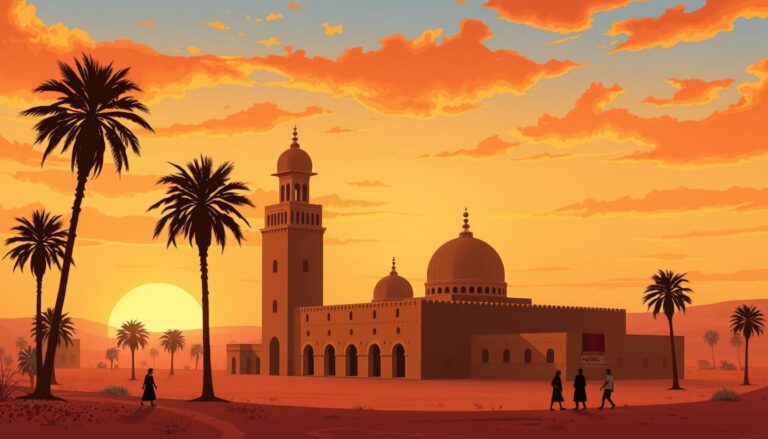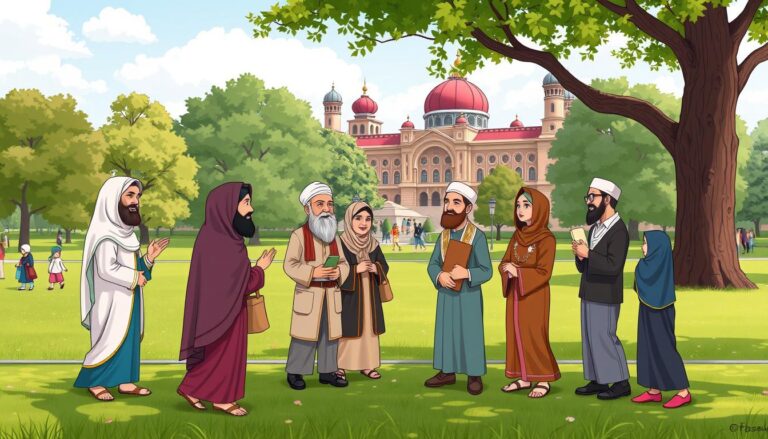Islam in Chad
Islam is the main religion in Chad, with about 55% of people calling themselves Muslim. The first Muslims arrived in Chad in the 7th century AD. Since then, Islam has become a big part of Chadian life, bringing people together despite their differences.
Today, Islam is still very important in Chad’s culture, politics, and everyday life.
Chadian Muslims pray more than once a week, often not in a mosque. They might not make the pilgrimage as often as others. Some even fast during Ramadan, not even swallowing saliva during the day.
Most Chadian Muslims, 95%, are Sunni. Shia Muslims make up 1%, and 4% follow other beliefs. Many follow the Sufi Tijaniyah tradition, while some believe in Wahhabism, Salafism, or the Muslim Brotherhood.
Introduction to Islam in Chad
Islam has a deep history in Chad, starting in the 7th century AD. The historical background of Islam’s arrival and spread in Chad is key to understanding. The conversion of the Kanem-Bornu Empire in the 11th century was a major turning point in the Islamization process.
Today, Islam is a big part of Chadian culture, shaping the country’s identity and social structures. About 55% of Chadians are Muslim, mostly from the Sunni branch of Islam. The importance of Islam in Chadian society is huge, affecting traditions and governance.
“Islam has become deeply rooted in Chadian culture, shaping the country’s identity and social structures.”
Historical Background
The historical background of Islam in Chad goes back to the 7th century AD. The religion came to the region as part of the Muslim conquest of the Sudan. The conversion of the Kanem-Bornu Empire in the 11th century was a big step forward.
Importance of Islam in Chad
Islam is very important in Chad today. With about 55% of the population Muslim, the religion is deeply woven into the culture. It influences traditions, social structures, and even governance. Islam’s impact on Chad is clear, making the nation unique.
Spread and Influence of Islam in Chad
The spread of Islam in Chad was slow. It was driven by contact with Muslim traders and pilgrims from West Africa. Over time, Islam became a big part of Chad, bringing people together and changing culture.
By the late seventh century A.D., Muslim conquerors had reached North Africa. They moved south into the desert. By the fourteenth century, Arab migrants arrived from the east. Chadian Muslims mixed old traditions with Islam, creating a unique culture.
Most Chadian Muslims belong to the Tijaniyya order. The Sanusiyya brotherhood is rare in some areas. Chadian Islam follows the Maliki legal school, but education mainly focuses on the Quran.
Higher Islamic education is hard to find in Chad. Students and scholars often go to Khartoum or Cairo for it. Chadian Muslims follow the five pillars of Islam but with some differences.
“The spread of Islam in Chad has been a gradual process, adapting to the local context over the centuries and influencing various aspects of Chadian culture.”
In summary, the spread of Islam in Chad was slow but deep. It has shaped Chadian society in many ways. Chadian Islam shows the country’s rich cultural heritage.
Major Islamic Groups and Sects
In Chad, most Muslims (around 95%) follow Sunni Islam. A smaller group (about 1%) is Shia. Sunni Muslims live mainly in the north, east, and center of Chad. Shia Muslims are mostly found in specific communities.
Chad also has a few other Islamic groups and traditions.
Sunni Islam in Chad
Sunni Islam is the main Islam in Chad, with over 25.8% of people following it. Sunni Muslims in Chad follow the Quran and the Sunnah, the Prophet Muhammad’s traditions. They focus on the five pillars of Islam: faith, prayer, charity, fasting, and pilgrimage to Mecca.
Shia Islam in Chad
The Shia Muslim population in Chad is about 11.2% of the religious community. They believe in the Prophet Muhammad’s descendants, the Imams. Shia Muslims in Chad have their own religious practices and festivals.
The variety of Islamic sects in Chad shows the diversity of religious beliefs and practices. Understanding Sunni and Shia Islam, and other groups, helps us see Chad’s religious complexity.
Islamic Practices and Traditions
Chad, a Central African nation, has a big Muslim population. Over 53.9% of its 18.5 million people follow Islam. The Islamic faith is deeply rooted in Chad’s culture. Most Muslims in Chad follow the Five Pillars of Islam.
The Five Pillars of Islam
Chadian Muslims follow the five pillars of Islam. These include:
- The shahada, or the declaration of faith in the oneness of God and the acceptance of Muhammad as His prophet.
- Salat, the practice of performing daily ritual prayers.
- Zakat, the obligation to give a portion of one’s wealth to charity.
- Sawm, the observance of fasting during the holy month of Ramadan.
- Hajj, the pilgrimage to Mecca, which every Muslim is expected to undertake at least once in their lifetime.
Ramadan Observances
The month of Ramadan is very important for Chadian Muslims. During Ramadan, people don’t eat, drink, or do worldly things from sunrise to sunset. In Chad, some people even don’t swallow their saliva during the day.
“The month of Ramadan is that in which was revealed the Qur’an, a guidance for the people and clear proofs of guidance and criterion.” – Quran 2:185
The end of Ramadan is celebrated with Eid al-Fitr. It’s a time of joy, feasting, and giving gifts to family and friends.
While Islamic practices in Chad mostly follow the orthodox version, there are local variations. These reflect the unique cultural and social influences on Islam in Chad.
Islam in Chad
Islam is the main religion in Chad, with about 55% of the population being Muslim. Most Muslims live in the north, east, and center of Chad. Islam has greatly influenced Chadian culture, affecting social norms, architecture, and education.
Chad’s Muslim population is varied, with different sects and traditions. Most Chadians follow Sunni Islam, with a smaller number of Shia Muslims. Islamic practices are a big part of daily life, from Ramadan to building mosques and schools.
The Islamic influence in Chad goes beyond just religion. It has shaped the country’s culture and buildings, with mosques and Islamic designs everywhere. Islamic schools and universities also play a big role in education.
“Islam has become a unifying force in Chad, transcending ethnic divisions and fostering a sense of shared identity among its diverse population.”
Even though Islam is the main religion, Chad is not just one faith. Other religions like Christianity and traditional African beliefs also exist. This diversity makes Chad’s culture rich and promotes religious tolerance.
Islamic Education and Scholarship
In Chad, finding higher Islamic education is hard. Many students go abroad for advanced studies, like to Al-Azhar University in Egypt or Sudan. But, there are a few places in Chad that offer religious education and training.
Islamic Institutions and Centers
Chad has universities and institutes for different subjects, including Islamic studies. King Faisal University in Chad is a key player in education. The country also has a long history of Islamic scholarship, especially from 1200 to 1600 AD.
But, today’s world brings new challenges. Scholars now focus on Arab culture in Chad and keeping its Islamic identity. The International Scholarly Conference for Democracy, Peace, and Development in the Era of President Idris Déby in N’Djamena talks about education, including Islamic studies.
The education system in Chad mixes old Islamic ways with new university structures. Islamic groups and universities shape the country’s learning and culture. Chadian writers and scholars talk about the value of education and scholarship in Islam.
“The academic sector in Chad appears to be dynamic, with ongoing discussions and efforts focused on enhancing educational opportunities and outcomes in the country.”
Mosques and Islamic Architecture
Mosques are key parts of Chad’s culture and faith. They are important places for Islamic worship and community life. You can find them in many big cities and towns across the country.
Chadian mosque architecture is special. It mixes traditional building ways with Islamic design. The mosque in Abéché is a great example. It has beautiful patterns, domes, and minarets typical of Islamic buildings. But it also uses local materials and construction methods.
- Mosques in Chad are centers of spiritual and social life. They host daily prayers, religious events, and community meetings.
- The styles of these mosques vary. Some show influences from North Africa and the Middle East. Others have unique Chadian designs.
- Many Chadian mosques use local materials like mud bricks and thatched roofs. This makes them stand out in the Islamic architecture in Chad.
These places are not just important for religion. They are also cultural landmarks. They help keep Islam’s history and traditions alive in Chad. As more Muslims live in Chad, these mosques in Chad show the lasting role of Islamic faith in the country.
“The mosques of Chad are not just houses of worship, but also repositories of the country’s architectural heritage, reflecting the diverse influences that have shaped the region over centuries.”
Mosques in Chad range from grand buildings in N’Djamena to simple ones in rural areas. They are symbols of the strong bond between Islam and Chadian culture.
Integration of Islam with Local Cultures
Islam in Chad has blended well with local cultures and traditions. This mix has created a unique blend of Islamic and African beliefs. Chadian Muslims keep Islamic teachings strong while adding local customs to their faith.
The mix of Islam and local cultures started in the 11th century. Early Arab and North African settlers brought Islam to the region. By the 13th century, Islamic influence grew with the conquest of the Kingdom of Gao.
This blending has made Islam a big part of Chadian society. The Songhay Empire, from the 1430s to 1591, supported Islamic learning and built important mosques. Timbuktu, a key trade and learning center, also grew during this time, showing Islam’s deep roots.
In Chad, Islamic and African traditions mix in art and design. Traditional African items show both Islamic and African styles. Islam also influenced African love for geometric patterns in textiles and crafts.
Islam’s spread in Chad has been key to its acceptance. This blending of faiths with local traditions has enriched Chadian culture. It has made Islam a vital part of Chadian identity.
Role of Islam in Chadian Society
Islam is key in shaping Chadian society, culture, and identity. It’s the main religion, with over 52% of the population. It influences daily life, including social customs, architecture, and education. It also unites the diverse ethnic groups in Chad.
Even though other religions like Christianity and animism exist, Islam is at the heart of Chadian society. The Impact of Islam on Chadian culture is clear in the many Islamic practices, festivals, and traditions.
The Role of Islam in Chadian society goes beyond just religious practices. It also shapes the political scene. Islamist views are common among a third of Muslims, especially those with certain educations. This has made it hard for leaders to balance religion, ethnicity, and governance.
Chad faces big environmental challenges like desertification and drought. These issues have made old conflicts worse. This has led to the rise of militias among different ethnic groups. Islam plays a part in these conflicts as groups try to show their power and identity.
In summary, Islam’s role in Chadian society is complex. It touches on religion, culture, politics, and social life. As Chad deals with its diverse society, Islam’s influence will keep shaping the country’s future.
“Islam has served as a unifying force, bridging the diverse ethnic groups within Chad.”
Challenges and Controversies
Islam is deeply rooted in Chadian society, but it faces challenges and controversies. One big challenge is the lack of higher Islamic education in Chad. Many Chadian Muslims go abroad for religious training. This can lead to tensions, as some see these changes as not true to orthodox Islam.
The integration of local customs and traditions with Islam also causes friction. Some see these changes as not following the true teachings of Islam. This leads to disagreements and debates within the community.
Despite these challenges, Islam remains important in Chadian society. It adapts to the country’s unique culture and society, staying relevant and influential.
“The Sahel region has experienced a surge in violence, conflict, and crime over the last decade, transcending borders and posing significant challenges to countries both within and outside the region.”
One major controversy is the presence of former Boko Haram fighters in Chad. About 2,200 former fighters live in Chad, with 1,200 in the Medi Koura settlement. Their reintegration is hard due to a lack of schools and healthcare.
There’s also worry about former fighters going back to Boko Haram. This is because they face many challenges in rebuilding their lives. These issues highlight the complex challenges Islam faces in Chad, especially after violent extremism.
Conclusion
Islam is a strong presence in Chad, deeply tied to its history, culture, and society. It arrived in the 7th century and now over half the population follows it. This faith has shaped Chad’s identity and social structures.
While local customs and traditions have blended with Islam, it remains a uniting force. It connects diverse ethnic groups and influences many aspects of Chadian life.
As Chad grows, Islam’s role will keep shaping its future. The government’s efforts to manage religious activities show the faith’s importance. This balance between Islam and other religions will continue to shape Chad’s society and politics.
The lasting impact of Islam in Chad shows its deep roots and resilience. As Chad moves forward, Islam’s influence will be key to understanding and guiding the nation’s path.
Source Links
- Islam in Chad
- Religion in Chad
- Chad – United States Department of State
- Tolerance and Tension: Islam and Christianity in Sub-Saharan Africa
- Chad – United States Department of State
- Islam (Chad)
- Chad – Islam in Chad
- Religious Beliefs In Chad
- Chad Religions – Demographics
- Full Country Dossier Chad 2024…
- Chad – United States Department of State
- 71. Chad (1960-present)
- Chad: A ‘small flock’ of Christians in the desert
- King Faisal University in Chad: Challenges, Opportunities, and Future Prospects
- No title found
- Building a mosque in Chad – Afrika Hayat
- Visiting Chad? Here’s a Muslim-Friendly Guide
- The Spread of Islam in West Africa: Containment, Mixing, and Reform from
- Trade and the Spread of Islam in Africa | Essay | The Metropolitan Museum of Art | Heilbrunn Timeline of Art History
- Islamist terrorism is rising in the Sahel, but not in Chad – what’s different?
- Chad – Minority Rights Group
- Violent Extremism in the Sahel | Global Conflict Tracker
- The Challenge of Boko Haram Defectors in Chad – War on the Rocks
- CHAD 2017 INTERNATIONAL RELIGIOUS FREEDOM REPORT

